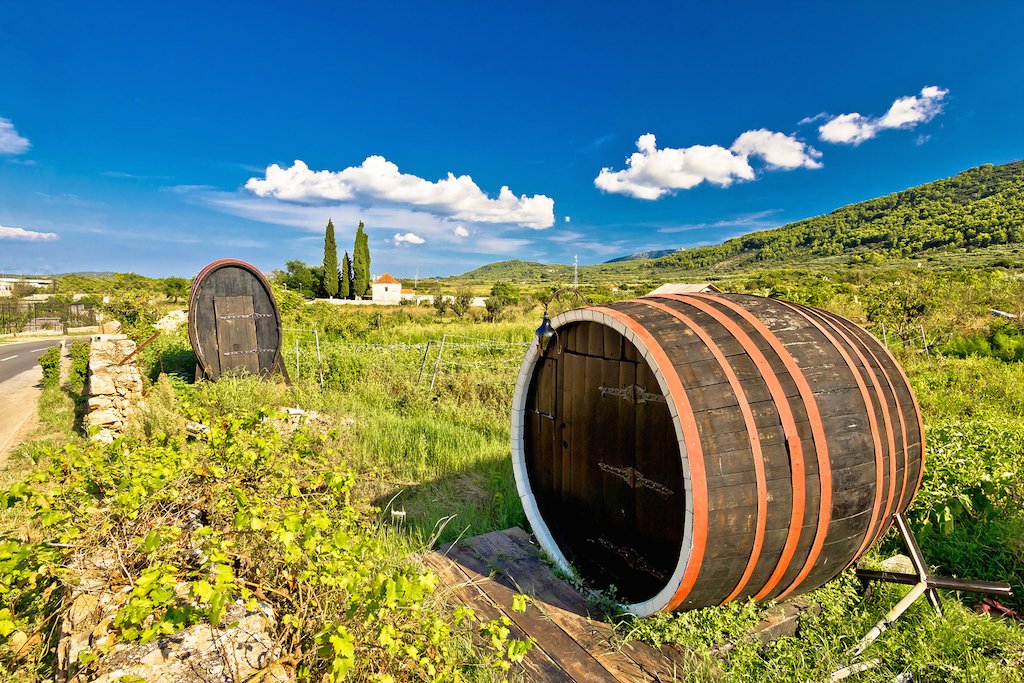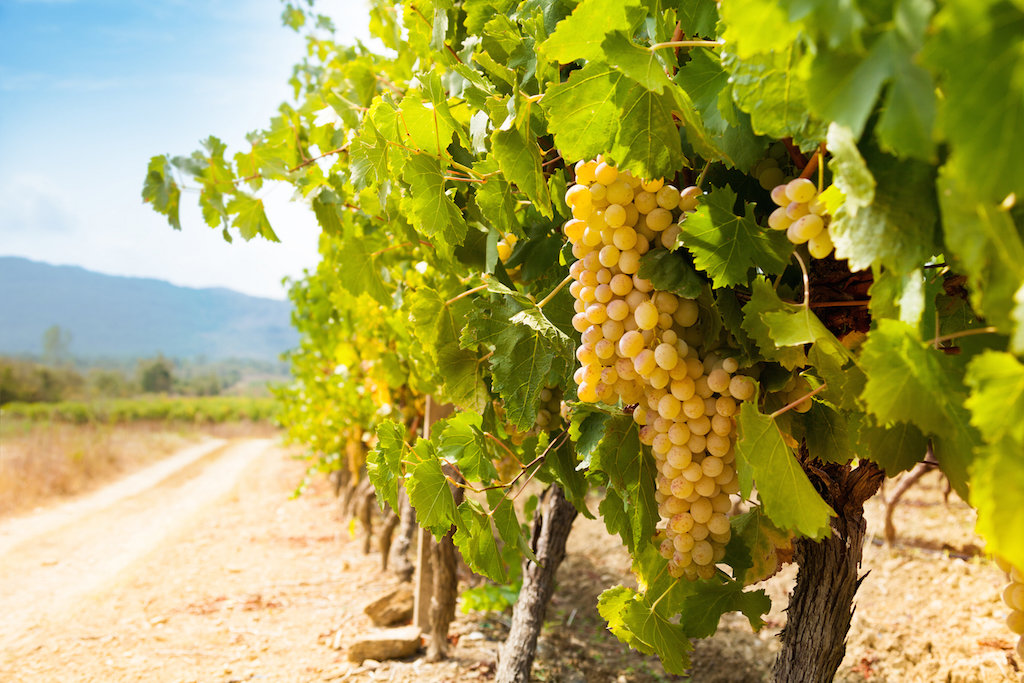
Secrets of Croatia’s Wine Country

Get Inspired in Istria

Grapes have been growing in Istria, the northwestern region of Croatia, since the Greeks and the Romans planted them more than 2,000 years ago. Residents of the Adriatic’s largest peninsula have been making wine ever since. The area holds roughly 120 small, family-owned wine producers, and until recently, few Istrian wines were known outside Croatia.
In 2015, Wine Enthusiast magazine named Istria one of the top 10 wine travel destinations in the world, catapulting it into the company of wine regions like Italy’s Piedmont and France’s Rhone Valley. As a result, oenophiles flock to this region overflowing with vineyards, hilltop castles, sublime cuisine, and people who seem to have invented the concept of hospitality. The area is best known for the native white wine Malvazija Istarska, whereas the vineyards with iron-rich terra rossa soils are renowned for their production of rich red wines from grapes like the endemic Teran and Refošk.
Some of the most exciting places to taste Istria's best wine and food are:
Savudrija, in the extreme northwest corner of the peninsula. It is where Moreno DeGrassi presides over his tasting room, konoba, cellar, and award-winning vintages. DeGrassi winery produces 130,000 bottles of wine a year made from French grapes planted by a government co-op during Tito’s reign. The vines are now mature, and DeGrassi’s talent as a vintner has made the resulting wines remarkable. He continues to sell most of his wine in Croatia, but demand has grown, and his exports are ever-increasing.
Momjan, less than half an hour southeast of Savudrija on a hill that affords incredible views of the surrounding landscape and the Adriatic. It is divided into upper Momjan, where ruins of the 13th-century Momjan Castle oversee the terrain. St. Martin’s Church in lower Momjan is much newer—from the 15th century. Momjan also is the gateway to the wine and olive oil roads of northern Istria and home to the acclaimed Kozlović winery. Owner and winemaker Gianfranco Kozlović was the first Istrian winemaker to win a national award (1998) when his Malvazija was named the best white in Croatia. His winery welcomes visitors for tours and tastings, but call ahead as reservations are required.
Expert tip: Momjan hosts an annual Bike-Wine Marathon in November to celebrate the town’s patron saint, St. Martin. St. Martin also happens to be the patron saint of wine and wine growers, which is suitable for sampling the new vintage like that of Beaujolais Nouveau.
Outside Momjan, on the way south to Buje via a steep, winding road, the Kabola winery is presided over by owner Marino Markežić. He employs English-speaking staff and welcomes drop-in visitors. Besides offering classic Istrian wines, like white Malvazija and red Teran, among others, Kabola has a small wine museum, a tasting room, and Marino Konoba, Markežić’s Michelin-star-worthy restaurant.
Expert tip: Famous for truffles, the Istrian peninsula's forests are home to both black and white varieties where you can expect towns to host fall festivals that honor the delicacy. See this family-friendly itinerary that features a day of hunting for truffles in a forest outside of Motovun.
Sipping in Slavonia

Just 100 miles east of Zagreb is the fertile Pannonian Plain that runs all the way to the Danube. The towns and villages along the way—Požega, Kutjevo, and Baranja—deliver a historical perspective and some of the most rewarding wine touring experiences in the country. There are nearly 30 wine cellars on three distinct wine roads in this part of western Slavonia, and each has a unique character where Graševina and Traminac, more commonly known as Gewürztraminer, are this area’s main varieties.
Požega-Pleternica was once called Vallis Aurea (Golden Valley) by the Romans who settled there. This basin, surrounded by the Slavonian mountains, has been producing wine for centuries. Now it is emerging as a center of food and wine tourism.
There are seven wineries spread over 390 acres on the Požega-Pleternica vinska cesta (wine road). For a more active experience, you can hike or bike the route and even climb Požeška Gora along the way.
The Kutjevo wine road covers twice as much territory as Požega-Pleternica (800 acres). Its 20 wine cellars are among the region’s oldest and most acclaimed, with one dating from the 13th century. Kutjevo also is a gateway to gorgeous Papuk Nature Park, where visitors can book organized tours or cycle along six trails: three in Papuk and three in Kutjevo. Hiking and rock climbing are also popular here. Or, you can enjoy the endless forested landscape and the park’s diverse collection of rocks and fossils.
The vineyards of Pakrac were close to the front lines of the Homeland War, and they still are recovering from the devastation they sustained. In the meantime, you can see their progress and visit nearby Lipik’s thriving equestrian center. Several eco-farms are open for tours. Others offer fishing, biking, and the opportunity to visit a goat farm and an apiary for a first-hand look at the sources of sweet and savory products like goat cheese and honey.
Požega may have its Golden Valley, but Baranja, in the northeastern part of Slavonia, has its Mons Aureas (Golden Hills). The name came from the Romans who built settlements along the Danube and recognized the suitability of Baranja for growing grapes.
The legendary Iločki Podrumi (Ilok Cellars) are here in Ilok, which is one of the first towns Serbian forces entered when they crossed the Danube on their way to war in 1991. Most of the 20 wineries in Baranja are family-owned and small, and many also offer food and lodging.
Baranja is close to Kopački Rit Nature Park and its biking and hiking routes, so it’s easy to combine a nature walk or ride with a few winery stops. With its many local organic farms, Baranja is a popular destination for agrotourism, and it was one of the first areas to develop trails for cycling tourism.
Expert tip: Many places in Baranja rent bikes where the county officials are working with neighboring Hungary to create an international bike rental service.
A narrow spit of land that juts into the Adriatic west of the mainland and north of Dubrovnik is hot and rocky which might seem inhospitable for growing anything, but it produces magnificent grapes. Some of Croatia’s most celebrated winemakers like Dingac and Postup are here. Grgić, the cradle of the Grgich wine label from California, is here too, in the village of Trstenik.
There’s even a place that sells its wine on the honor system. Bring a container and take as much vino as you want from outdoor barrels. Then leave money. Indijan Winery is a curiosity that has been in business for ages. There are also wine cellars with more traditional tasting rooms dotted throughout the Pelješac peninsula, but most require advance notice for tasting.
And if you find you need a break from all that sipping, there’s always the opportunity to jump into the sea from wherever you are.
Expert tip: Biking is a popular way to move along on the Pelješac wine route, but be warned that the terrain is extremely hilly.
Taste History on Korčula, Hvar, and Vis

The “big three” wine-producing islands of southern Dalmatia have a lot in common:
- They produce excellent wines.
- Their biggest population centers are at extreme ends of their respective islands.
- They were once inhabited by the ancient Greeks.
- They're perfect for cyclists who want to travel the islands from end to end. The vineyards and wineries are nestled mid-island, usually in valleys surrounded by hills, which makes for an interesting and doable ride, even for day-trippers.
Despite the similarities, each island has a distinct personality.
Vis is a mysterious island and the smallest of the three. It also is one of the farthest from the mainland and the least touristy, thanks to Tito’s restrictions on visitors during World War II. Vis has spectacular secluded coves that lie in the shadow of jagged cliffs, a sophisticated dining scene, and an upscale yachting clientele. There’s even a winery with World War II memorabilia left behind in one of Tito’s communication caves built into a hill. Whites made from the Vugava grape lead Vis’ wine production.
Korčula is the reputed birthplace of Marco Polo, though no one can prove it. With its walled city center and cobbled streets, it is the most medieval-looking of the islands giving the appearance of a Dubrovnik Mini-Me. Korčula has a reputation for excellent white wines made from the Grk and Pošip grape, where Smokvica and Lumbarda are the best-known winemaking towns on the island. Sitting on a very hilly road with spectacular views of Smokvica's vineyards, rests Vinarija Toreta, a regular stop with food-and-wine bike tourists. Find out about a fun wine and cycling tour given by Korčula locals Rachael and John with this experience.
Hvar is just 20 miles off the coast from Split and has been a center of viniculture since the 4th century BCE when the Greeks planted vines in the Stari Grad Plain, A UNESCO-protected site. Cyclists can enjoy a ride similar to Korčula’s, complete with vineyards, hills, and valleys. Zlatan Plavac is its grape, but Hvar may be more famous for its wine drinking than its winemaking. The island is known for lavender fields, its luxurious hotels and villas, and its raucous celebrity party scene. Read more about things to do in Hvar here.

